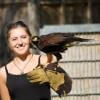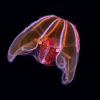Wildlife crime is one of the greatest challenges facing conservation, and one of the conservation tech world's biggest areas of innovation. With new ideas and solutions constantly being put forth to track and protect species targeted by poachers, manage protected areas and support rangers, and combat the growing online market for illegal wildlife products, the engineers and conservationists working to solve wildlife crime's many challenges rely on tools like machine learning, biologging, camera traps, acoustic monitoring, drones, mobile apps, and more.
This wide variety of overlapping technology makes our Wildlife Crime group a potential melting pot for many of our other communities, and makes it an especially exciting place to find collaborators working in different tech spheres to meet a common goal. Whether you're a camera trap expert looking for information on thermal vision to spot potential poachers, a machine learning expert with the skills to analyze acoustic data for gunshots, or a protected area manager seeking the latest integrated mobile tools, this group can connect you with the right members of our community!
Below, you'll find WILDLABS resources and conversations to help you understand how different technologies are being put to work in the fight against wildlife crime, and what conservation tech practitioners need for these tools to be effective.
Three Tutorials and Videos for Beginners:
- How do I use AI to fight wildlife crime? | Lily Xu, Tech Tutors
- WWF Wildlife Crime Technology Project | Eric Becker, Virtual Meetups
- SmartParks | Laurens de Groot, Virtual Meetups
Three Forum Threads for Beginners:
- Snare detection technologies | Rachel Kramer
- Tools for conservation management | Chris Muashekele
- Looking for Intelligence Database Software | Dexter Oelrichs
Three Articles for Beginners:
- Using AIS data to investigate the world's fishing ports, Max Schofield
- How do Wildlife Crime Experts view Remote Sensing Technologies used to Combat Illegal Wildlife Crime?, Isla Duporge
- Metal Detecting Sensors for Anti-Poaching, Sam Seccombe
Join this group now to get to know our community and start discussing solutions and ideas together!
Header photo: © Frank af Petersens/Save the Elephants
PhD student with research focused on using on-site DNA sequencing for rapid species identification. Interested in wildlife forensics, and conservation genomics.
- 0 Resources
- 0 Discussions
- 4 Groups
I am a forensic geneticist with a long term interest in developing and applying DNA markers to combat wildlife crime. Currently developing and validating STRs for raptors and rapid on-site species ID using the ONT MinION portable sequencer.
- 2 Resources
- 0 Discussions
- 5 Groups
- @Gody
- | He
Godfrey Nyangaresi, a dedicated Protection Manager with 12+ years of wildlife conservation experience. Skilled in technologies, administration, and law enforcement, he leads protection efforts at STEP, ensuring the sustainable conservation of elephants in southern Tanzania.
- 0 Resources
- 3 Discussions
- 17 Groups
- @RHugtenburg
- | He/They
Student at Aberystwyth University. Bug Fanatic🪲. Worked at Octophin Digital for my industrial year placement 🐙.
- 0 Resources
- 0 Discussions
- 20 Groups
- @kadambarid
- | she, her, hers
Dr. Kadambari Devarajan is an engineer-turned-ecologist working on biodiversity monitoring. (Website - http://kadambarid.in/)
- 0 Resources
- 0 Discussions
- 14 Groups
- 1 Resources
- 0 Discussions
- 13 Groups
- @samarmstrong
- | She/her
International Union for the Conservation of Nature (IUCN)
Invasive species/law enforcement/project management/Asia/Australia

- 0 Resources
- 0 Discussions
- 4 Groups
- @brittanypalmer
- | she/her
Entrepreneur and environmental attorney with a passion for wildlife conservation.
- 0 Resources
- 0 Discussions
- 4 Groups
- 0 Resources
- 2 Discussions
- 1 Groups
- 0 Resources
- 2 Discussions
- 2 Groups
Entrepreneur building AI-driven acoustic monitoring technology for comprehensive wildlife conservation, protection and ecosystem health monitoring.

- 0 Resources
- 0 Discussions
- 4 Groups
University of Madras
Research Coordinator
- 0 Resources
- 2 Discussions
- 1 Groups
When Victoria Espinel, President and CEO of BSA | The Software Alliance, spoke at the WWF Fuller Symposium, she took us on a whistle-stop tour of case studies where software and data are transforming our understanding...
10 March 2016
We are living in the midst of a pretty exciting era. Never before has humanity been more educated, more connected, more enabled, or more empowered than we are today. There are many reasons to be optimistic about the...
17 February 2016
New horizon scanning report published this month identifies 15 emerging threats and opportunities for global biodiversity.
3 February 2016
From artificial “sniffer” technologies to portable DNA sequencers, the Wildlife Crime Tech Challenge received hundreds of innovative ideas to help stamp out wildlife crime. Now, the Challenge is proud to announce 16...
22 January 2016
Gary Atkinson, Director of Emerging Technologies at ARM, explains why we should be interested in the Internet of Things. Could it be a game changer for conservation?
10 December 2015
Can games have real world impacts on issues like the illegal wildlife trade? In part two of his case study for the Gaming for Conservation Group, Peter Jacobs discusses United for Wildlife's efforts to engage young...
3 December 2015
The 2015 Fuller Symposium brought together thought leaders in science, policy, business, conservation and development to tackle emerging issues facing our planet. This framing piece was developed to support a Fuller...
26 November 2015
Article
Traceability (knowing where products come from and how they are made) is a foundational pre-cursor for many sustainability interventions. While many tools have been developed to offer high-level insight about the...
26 November 2015
Can games raise awareness of conservation issues like the illegal wildlife trade? In part one of his case study for the Gaming for Conservation Group, Peter Jacobs discusses how United for Wildlife is partnering with...
25 November 2015
Article
Environmental DNA (eDNA) is nuclear or mitochondrial DNA that is released from an organism into the environment. Sources of eDNA include secreted faeces, mucous, gametes, shed skin, hair and carcasses. In this article,...
2 November 2015
June 2025
event
July 2025
November 2018
event
42 Products
1 R&D Projects
41 Organisations
Recently updated products
Recently updated R&D Projects
Recently updated organisations
| Description | Activity | Replies | Groups | Updated |
|---|---|---|---|---|
| The Journal of Animal Ecology with the Journal of Applied Ecology and Methods in Ecology and Evolution have published a... |
|
Wildlife Crime | 9 years 4 months ago | |
| Watch streaming footage here of John Amos, President of Sky Truth, speaking on Cheap Space, DIY Imaging and Big... |
|
Wildlife Crime | 9 years 6 months ago |

















